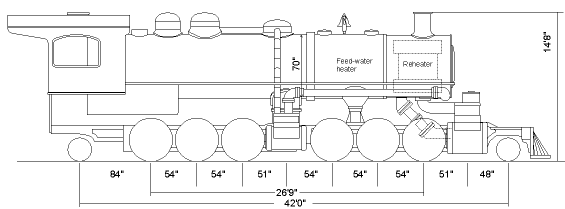

Baldwin Class: 16-31/50-1/4-DD, 1
Type: 2-6-6-2
Tank or tender type: Rectangular tender
Build date: December 1910
Baldwin Construction Number: 35785
Tractive Force: 50,000 lbs.
|
Gauge: 4'8.5" (standard gauge) Cylinders: 18.5" and 28" x 28" Valves: Balanced Slide Boiler:Type: Straight Material: Steel Diameter: 70" Thickness of Sheets: 11/16" Working Pressure: 200 lbs. Fuel: oil Staying: Radial Boiler Jacket: Planished Iron Firebox:Material: Steel Length: 96" Width: 62.75" Depth: front, 66"; back, 57" Thickness of Sheets: sides, 3/8"; back, 5/16"; crown, 3/8"; tube, 1/2" Water Space, front, 5"; sides, 4"; back, 4"
|
TubesMaterial: Charcoal Iron Thickness: #12 W.C. Number: 321 Diameter: 2" Length: 13'0" Heating SurfaceFirebox: 148 sq. ft. Tubes: 2,171 sq. ft. Feed Water heater tubes: 1,006 sq. ft. Reheater: 421 sq. ft. Total: 3,325 sq. ft. Grate Area: 41.8 sq. ft. Driving WheelsDiameter Outside: 51" Diameter of Center: 44" Journals, main: 8" x 9" Journals, others: 7" x 8"
|
Engine Truck WheelsDiameter, front: 28" Journals: 5" x 8" Diamter, back: 28" Journals: 5" x 8" Wheel BaseDriving: 26' 9" Rigid: 9' 0" Total Engine: 42' 0" WeightOn Driving Wheels: 202,000 lbs. On Truck, front: 15,000 lbs. On Truck, back: 15,000 lbs. Total Engine: 232,000 lbs. TenderWater, 5,000 gals. Oil, 2,000 gals. Tender wheels diameter: 30" Weight, with fuel and water, about 100,000 lbs Short pilot on back of tender. (BLW card 3631 approved)
|
Painting, style 291 Engine, Olive green and aluminum
Painting, style 291 Tender, Olive green and aluminum
Mark on tank, PORTLAND & SOUTHWESTERN R.R. CO.
Mark on rear of tank, 5000 GALS.
Number Position: Front number plate, top sand box, sides of cab.
1910 -1918:
Portland & Southwestern RR (Chapman Timber Company).
#2. Scappoose, OR.
1918 -
19**: Alton & Southern Railroad
#8. East St. Louis, IL
Scrapped.
This large, one of a kind logging Mallet was built for the Chapman Timber Company in 1910 for use on their Portland & Southwestern Railroad as its #2. With 51-inch driving wheels and a weight of 232,000 lbs, Chapman #2 was much larger than the previously built 2-4-4-2 and 2-6-6-2 logging Mallets. Chapman's logging operations were in the area of Scappoose, Oregon, west of Portland. At the time #2 was built the Portland & Southwestern Railroad was short, about eight miles long, but the company had big plans to expand to the coast at Nehalem. Progress towards this western expansion was slowed by finances and a tunnel project that lasted several years. In 1918, two years before completion of the tunnel, P&SW sold #2 to the Alton & Southern Railroad in East St. Louis, Illinois. Renumbered 8, the Alton & Southern used the Mallet in transfer service into the 1930s. At some later point the Mallet was scrapped.
Chapman #2 was built with a Baldwin "separable boiler." With this style of boiler, used by Baldwin on some Mallets for a few years around 1910, only the rear portion of the boiler, up to just ahead of the high-pressure cylinders, is an actual steam generating boiler. This was the reason for Chapman #2's relatively short boiler tubes, only thirteen feet long, while the smaller tank Mallets like Booth-Kelly #2 had tubes that were seventeen feet long. Ahead of Chapman #2's front tube sheet was a flue gas feed-water heater, which occupied the remaining forward section of the boiler. Inside the smokebox was a Baldwin Reheater, another common feature on separable boiler Mallets. With this system, after steam left the high-pressure cylinders it was piped to the Reheater in the smokebox, then down to the low pressure cylinders, and then from the low pressure cylinders back to the smokebox and out the stack.
The benefit of the separable boiler system was a supposed increase in efficiency, both from the use of a feedwater heater, and from keeping the boiler tubes shorter. However, in practice the system was not completely successful. Some railroads like the Northern Pacific had trouble with cinders clogging the Reheater section and causing poor combustion. Many of the Mallets Baldwin built with these separable boilers were later converted to more conventional boilers with superheaters. Chapman Timber Company #2 was the only logging Mallet that had this type of boiler, and it apparently kept its separable boiler until retirement.
1. Specification for Locomotives: 16 31 50 1/4 DD Nos. 1 For Chapman Timber Co. Baldwin Locomotive Works, Philadelphia, PA. August 9, 1910. Copy from microfilm at California State Railroad Museum Library, provided by Jim Wilke.
2. Baldwin Locomotive Works, Record No. 68: Mallet Articulated Locomotives. Baldwin Locomotive Works, Philadelphia, PA. 1910
3. LeMassena, Robert A. Articulated Steam Locomotives of North America. Sundance Publications, Limited, Silverton, CO. 1979.
4. McCamish, Brian. "The Portland & Southwestern Railroad and the Nehalem Divide Tunnel." http://www.brian894x4.com/PortlandandSouthwesternRR.html.
5. Schmelzer, Ken. "Logging Mallets part 8." Narrow Gauge and Short Line Gazette. July/August 1977.
6. Schrenk, Lorenz P. and Robert L. Frey. Northern Pacific Classic Steam Era. Hundman Publishing, Inc. Mukilteo, WA. 1997.
7. Taubeneck, John A. Logging Mallets.